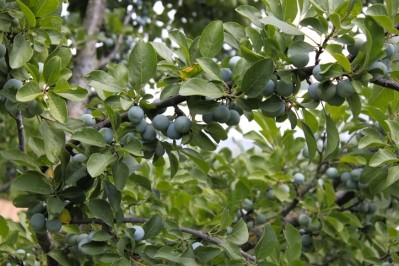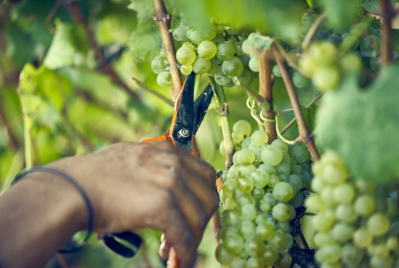Glass to gut: Using wine leftovers to make healthy ingredients
Each year, 20 million tons of wine byproducts are produced globally, and about one-fifth of that is generated in California.
Sonomaceuticals is using wine leftovers to make healthy ingredients. Using a process they developed to dry and mill grape marc, the company created WellVine Chardonnay Marc, an ingredient rich in bioactives. After toying around with several different foods and recipes, the company settled on Vine to Bar, a line of dark chocolate products that contain 15% of the chardonnay marc.
“Sonomaceuticals was founded by Barbara Banke and Peggy Furth. Barbara is the chairwoman of Jackson Family Wines and Peggy is the former proprietor of Chalk Hill Winery. The idea for Sonomaceuticals really came out of trying to find a higher, better use for the beautiful fruit that's left over after you make wine. So you take the juice and you make wine out of it, but then you have all of this wonderful fruit that you spent all this time and effort in making and they realize that there was something more you could do with it that it could be used for a variety of things,” explained Scott Forsberg, Chief Operating Officer, WholeVine Products.
“So somebody did most of the work for us already over the last 8000 years, then we came along, understood what it was, figured out how to preserve and protect that, did all of the hard work to understand what the composition was like so that we could respect it in the best possible way and created a whole food product that can be used to improve people's health in a holistic way,” explained Forsberg.
The venture began in 2009 and led to the subsequent discovery about a little known secret: white wine may actually confer more health benefits than red wine.
“Don't get me wrong, red grapes have some really fascinating things in there. Primarily resveratrol, which everyone has heard about, which is part of this family of polyphenols that we talk about and that we consider and those are great things, but the fact of the matter is that there are other things in white grapes that you don't find in nearly the same quantities that you find in red grapes, which are also very interesting and very good for you.
Forsberg added that chardonnay consistently came to the top in all kinds of tests, including measures of cardiovascular health, metabolic health and gut health.
“So we see a lot of things in white grapes that you wouldn't see in red grapes after the wine making process has started. And one of those things are an abundance of fibers and a diversity of fibers which we know are very good for feeding the bacteria that live in your gut. So that microbiome that everyone is talking about now, one of the best foods we've found to feed your microbiome actually turns out to be these pressed, chardonnay grapes,” he said.
University of California Davis researchers have been building on research to explore the health benefits of chardonnay marc, including the presence of oligosaccharides, a source of prebiotic fiber. That’s where Professor Daniela Barile, PhD, comes in. Her lab at UC Davis recently investigated the role of chardonnay marc on gut microbiome modulation using grapes grown in the vineyard on campus.
“We first started studying breast milk and we discovered the presence of many, many oligosaccharides and the main function was to establish a healthy microbiome in babies and then we decided to take it a step further and see where can we find similar oligosaccharides but in a product that's available to potentially translate to adults, so you would need a lot of mass. So that's where we stumbled across a chardonnay grape marc which turns out to be a great source of diverse oligosaccharides.
“Now, the building blocks are not exactly identical to the ones of breast milk–that would not be possible, but still we were very surprised by how much overlap there is by the diversity of 11 unique building blocks. That's a lot. The more diverse the structure of the prebiotic, the more possibility to have a selective activity on the human gut microbiome. And we had great results from collaborating with microbiologists on campus using fractions that we have isolated from the chardonnay grape marc to show that desirable probiotics are able to grow and consume these oligosaccharides, but pathogens absolutely cannot. So this is fantastic news because grape marc is so available, it's literally a byproduct of the wine industry and represents 30% of the mass of the initial grape that goes into the process of making wine. And it's under-valorized and it also contains phenolics which are equally fantastic for suppressing the pathogens. So now you have gut microbiome modulation into a former byproduct which is now actually being added as an ingredient in very pleasurable products like chocolate.”
Barile added that they are exploring the idea of combining the chardonnay marc with commercially-available probiotics to create new offerings with even more gut health benefits.
















